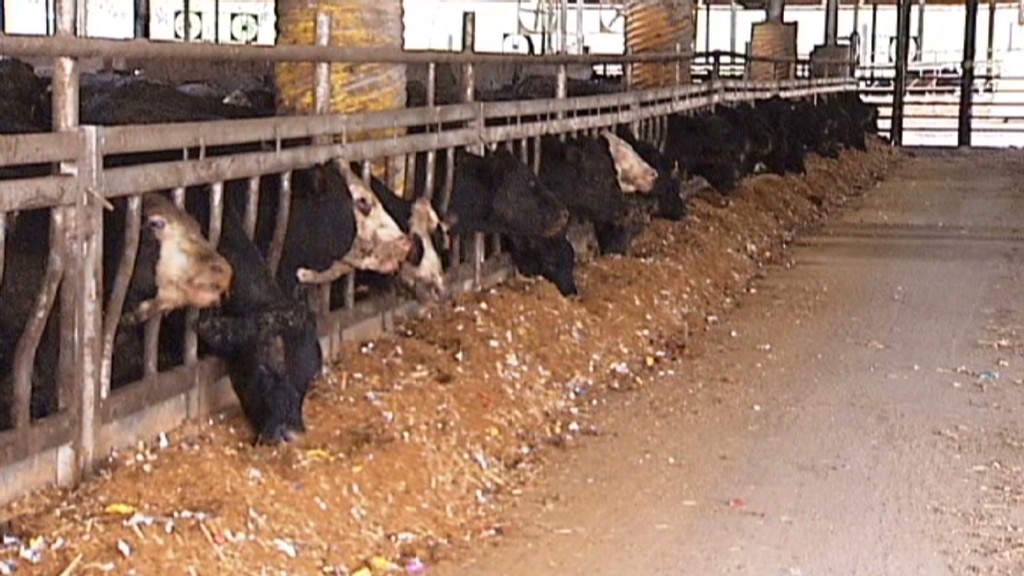
The American farmer might not be as poor as you think.
Despite the common notion that family farms have fallen on tough times and been pushed out by big agribusinesses, tens of thousands of families in the United States actually run multi-million dollar farming operations that produce the majority of the nation's food.
While million-dollar independent farms aren't the norm -- there are many times more small farms that struggle to make ends meet -- these slightly larger farms have been able to take advantage of their size, more advanced technologies and the recent commodity boom to become very successful small businesses.
"Times have been pretty good," said Matt Schuiteman, who has 2,400 hogs and farms 2,500 acres in northwest Iowa with the help of his sons and a few hired hands. "We've been dealing with an environment where the price of all commodities has been going up."
Schuiteman's farm is one of over 50,000 nationwide that have gross sales of over a million dollars a year, according to the United States Department of Agriculture.
Lumping in farms with sales of over $250,000 a year, and these so called large-scale commercial farms represent just 10% of the country's farms but account for 82% of its overall food production.
"People, on average, that are running large commercial farms are making substantial amounts of money," said Jim MacDonald, an economist at USDA, noting their the average household income is over $200,000 a year.
Related: Cash-strapped farmers feed candy to cows
What makes them so successful?
The biggest driver of their income is their ability to take advantage of their larger size. A farm with 300 dairy cows will produce ten times as much milk as a farm with 30 cows. But the barn to house those extra cows isn't ten times as expensive, nor is the equipment or the laborers to do the work. The payoff for more land is well worth the expense.
And these large independent farmers often have the means to supply the big food companies like Tyson Foods (TSN) or Dole (DOLE) with their raw product.
Plus, farm subsidies from the federal government, which are doled out largely based on the output of the farm, are another advantage. Subsidies, which total about $14 billion a year, represent about about 5% of the gross cash income for all farms, according to USDA.
Large farmers also have the capital to put down on new technologies that smaller farmers can't afford, like GPS-guided tractors that drive themselves (and save fuel) and computer programs that monitor the health and productivity of livestock. They're often more savvy at using hedging strategies to protect against future uncertainties.
"I call it an information technology gap," said David Miller, an economist at the Iowa Farm Bureau who also has a 350-acre corn and soybean farm outside Des Moines.
With sales of about $200,000 a year and profits of about $50,000, Miller considers himself on the borderline between large and small operator. He makes decent money, but his tractor is 20 years old and does not have GPS.
It also helps that he farms corn and soybeans in Iowa -- two crops that are in strong demand in China and elsewhere.
Related: Feds offer help to drought-stricken farmers
Things are very different for Clark Hinsdale, a dairy farmer in northern Vermont.
With 300 cows and sales that usually top a million dollars a year, Hinsdale has a large commercial farm. But with the high price of corn to feed the cows and gasoline for the tractors, turning a profit has still been tough.
"Grain prices have virtually doubled," he said. "I think I'll lose money this year."
It's even harder for many of his neighbors.
The Northeast is home to many smaller commercial farms. These are the 30-cow, 200-acre operations that many consider "traditional farms." There are about three times as many of these smaller farms nationwide as there are the large farms.
Most of these farmers can no longer support themselves by working the farm alone. The average farm income for this group is about $8,000 a year, according to USDA. As a result, many have at least one family member take a job outside the farm as a primary means of income.

But even though they may not be money machines, the farming lifestyle is still attractive for a lot of people.
"We don't need the big pickup and the fancy tractor," said one Vermont dairy farmer. "We do it because we enjoy it."


